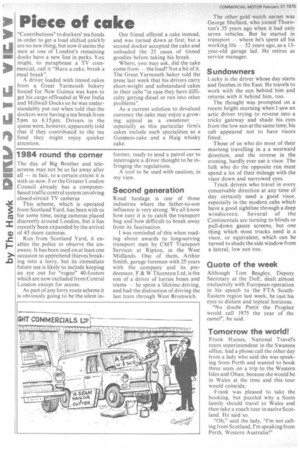1984 round the corner
Page 54

If you've noticed an error in this article please click here to report it so we can fix it.
The day of Big Brother and telescreens may not be so far away after all — in fact, to a certain extent it is with us now. For the Greater London Council already has a computerbased traffic control system involving closed-circuit TV cameras This scheme, which is operated from Scotland Yard, has been with us for some time, using cameras placed discreetly around London, but it has recently been expanded by the arrival of 45 more cameras.
Run from Scotland Yard, it enables the police to observe the unaware. It has been used on at least one occasion to apprehend thieves breaking into a lorry, but its immediate future use is likely to include keeping an eye out for "rogue" 40-footers which are now excluded from Central London except for access.
As part of any lorry route scheme it is obviously going to be the silent in former, ready to send a patrol car to interrogate a driver thought to be infringing the regulations.
A tool to be used with caution, in my view.
Second generation
Road haulage is one of those industries where the father-to-son influence is very strong. We all know how easy it is to catch the transport bug and how difficult to break away from its fascination.
I was reminded of this when reading about awards to long-serving transport men by CMT Transport Services at Ripton, in the West Midlands. One of them, Arthur Smith, garage foreman with 25 years with the company and its predecessor, F & W Thornton Ltd, is the son of a driver of lorries buses and trams — he spent a lifetime driving, and had the distinction of driving the last tram through West Bromwich.












































































































